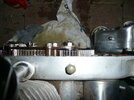Hi to all,
I have now arrived at the timing chest of my '51 Comet, I have found some small damage/wear to the large alloy idler and will be replacing it with a steel one.
You can see from the attached photo that the steady plate is quite distorted, it seems as though the Breather Valve Spindle has not been inserted far enough (the steady plate returns to pretty close to flat when removed)
I am wondering wether I should strip the timing gear and try to insert the Breather Spindle further or simply shim the other spindles to match its height, having never removed and retimed/replaced timing gear before?
Any and all suggestions appreciated.
Thanks
kevin

I have now arrived at the timing chest of my '51 Comet, I have found some small damage/wear to the large alloy idler and will be replacing it with a steel one.
You can see from the attached photo that the steady plate is quite distorted, it seems as though the Breather Valve Spindle has not been inserted far enough (the steady plate returns to pretty close to flat when removed)
I am wondering wether I should strip the timing gear and try to insert the Breather Spindle further or simply shim the other spindles to match its height, having never removed and retimed/replaced timing gear before?
Any and all suggestions appreciated.
Thanks
kevin

